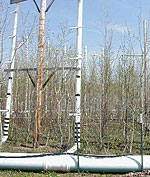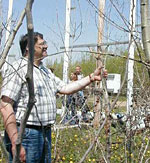By Bob Kelleher
Minnesota Public Radio
July 8, 2002
Scientists are growing trees in a northern Wisconsin forest in a bath of greenhouse gases, such as carbon dioxide and ozone. They want to know if trees can help limit global warming. Early results suggest the cocktail of pollutants produced by humans might endanger Upper Midwest forests. Scientists worry this may be offsetting any ability trees might have to slow an increase in world temperatures.
| |
|
|
|
||
It's called the Aspen FACE project -- Free Air Carbon Dioxide Enrichment. On the North Central Research Station's plantation near Rhinelander Wisconsin, some 12,000 trees are planted in wide rings. Most are aspen, but there's a sprinkling of birch and maple.
It's one of a dozen open-air carbon experiments worldwide. Each tries to measure how increasing carbon affects plants. The carbon comes from carbon dioxide, a gas that's been building in the world's atmosphere. Carbon dioxide is considered a leading culprit in global warming.
Dave Karnosky, who directs the aspen FACE project, is a forestry expert with the Michigan Technological University in Houghton, Michigan. Karnosky says there's still debate over carbon dioxide's role in global warming. But there's no denying the upward trend in temperatures, and the potential consequences.
"Things like glaciers melting on the North Pole, and sea level increasing, violent storms, increased frequency of violent storms, increased temperatures which will change the native range of plant communities and forestry communities," he says.
Aspen FACE is funded largely by the U.S. Department of Energy. It wants to know if trees can offset environmental damages from burning fossil fuels.
"Researchers have been very actively looking at how tree planting, and how forests, can be a net carbon sink; to remove carbon dioxide from the atmosphere, as an alternative to reducing emissions," according to Karnosky.
It's hoped that trees will absorb excess carbon in wood, and push carbon into surrounding soil. That might reduce the carbon in the air, and slow the greenhouse effect.
| |
|
|
|
||
Researchers are examining how forests are reacting to ever-increasing levels of carbon. Unique to the Wisconsin study, they're examining how the trees survive increasing ozone -- another greenhouse gas that's already a problem in urban areas.
"Will these forests remain as productive in the future? Will they be more productive, or less?" says Karnosky. "We talk about these as being sort of a window into the future. We like to think of our site as what the future climate will be, say, in the year 2050."
On a plantation near the Chequamegon National Forest, researchers are creating an atmosphere of the future. Fifty years from now scientists expect air, laced with more carbon and more ozone. The research site is eerily reminiscent of the ancient Stonehenge ruins in England.
Each ring is 100 feet across. The trees are head high, surrounded by a monument of pipes, which rise straight up maybe 10 feet higher, and connect across the tops. Sensors in the center measure wind and humidity, and the concentrations of carbon dioxide and ozone. A central computer directs high pressure jets of gas. A nearby shack serves as a computer center and researcher lunch room.
"Trees growing in a high concentration of carbon dioxide do well," reports Forest Service biologist Mark Kubiske. "Carbon dioxide is to a plant what oxygen is to an animal." Conversely, Kubiske says, trees grown in ozone pollution do poorly. Some aspen strains won't make it ten years.
"The very sensitive clones are starting to drop out of the experiment; they're dying early. And the less sensitive clones are tending to take over the site. So, the effect of the gases on the composition of the forests that we're investigating, is altering the way the different species and the different clones seem to interact," he says.
Combine ozone and carbon dioxide and you get a wash. At levels expected in this area in just a few decades, any benefit the trees get from extra carbon dioxide seems to be offset by the damaging effects of ozone. Trees grown in the combination grow about the same height as untreated trees. But there are other problems that don't portend well for northern forests.
"The aspen is growing about 20-percent faster than in the control plots," says Bill Mattson, a Forest Service entomologist. But in the ozone plots, trees not only grow slowly -- they get attacked by insects and fungus at a much higher rate. They also suffer from the attentions of animals and birds
"We've noticed that hares and rabbits, for example. They seem to respond to the smaller plants in a community, and so they start attacking smaller trees. You'll see lots of woodpecker injury; lots of sapsucker injury on those slower growing ozone trees," he says.
Trees grown in the two gases also face beetle infestation. They're riddled with small holes from word boring beetles.
"So if you add those two chemicals together -- ozone and carbon dioxide injected into the atmosphere -- it somehow is enhancing the success of the beetles that bore into the stems of these trees. That was something that I hadn't expected," according to Mattson.
It might be hard to sustain forestry here in 50 years. "Those two gases may, in fact, cause higher losses in forests, particularly to aspen forests, to wood boring insects," Mattson says.
Scientists are also considering other impact of trees exposure to the gases. There's evidence water moves differently through a tree under the gaseous conditions. Some trees have elevated tannins in leaves but reductions in other chemicals. That can have consequences on an ecosystem level, to the animals and insects that feed on trees.
Wisconsin's Aspen FACE is a relatively small, controlled experiment. But Mattson worries, there are no controls in the real world, where industry pours effluent into the air.
"It's a giant experiment with no controls. It's something to be watched very carefully, because we don't know what the ultimate consequences will be as we continue to ratchet up ozone and carbon dioxide," he says.
Aspen FACE is almost half way through it's 10-year project. Researchers will monitor the trees from sapling to maturity. When done, they may have a much better understanding how human industry will affect forests.
More from MPRMore Information


